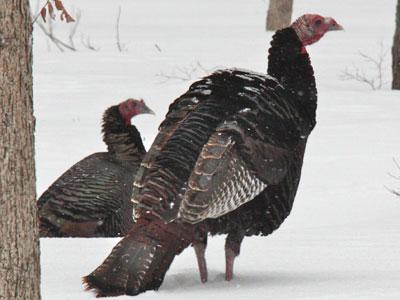Nature Notes: Plummeting Population

My ichthyologist buddy, Howard Reisman, who lives in North Sea, says that, notwithstanding the monthlong occupation of North Sea Harbor and other inlets and coves of the Peconics, the alewives are out there and ready to move in to Big Fresh Pond as soon as their passageway thaws. They have been arriving annually at this time every year like clockwork for at least a half-century and most likely for several centuries. The streamway connecting the harbor to the pond can be high or low, depending upon the standing level of the water in Big Fresh. When all the snow melts in the surrounding watershed in the next couple of weeks there should be more than enough water to ensure their safe passage.
The ospreys come next, and then the rush of new arrivals from the south is in full motion, not over until the last wood warbler passes through in late May. But not all of our spring and summer breeders will be back. During the new millennium certain birds have either dropped out or almost dropped out of the annual reproductive pool. Among them are many groundnesters, such as hermit thrush, ovenbird, bobwhite, ruffed grouse, and whippoorwill. Towhees are hanging on by their thumbs.
Interestingly, the greatest loss of these groundnesters has been on the South Fork, which is odd because the South Fork has so much in the way of woods and groundcovers. Each year now for the past five or six years, come May I have gone out looking and listening for these rarish birds. At night I have gone out to listen for one, the whippoorwill. Various theories have been put forth to explain their growing sparseness, when they all used to be fairly common.
One suggestion has been the introduction of wild turkeys on the South Fork, which got under way big time in January 1991. Wild turkeys can take over a woods, and in doing so compete for food and territory with other groundnesters. Others have blamed the feral cat population, which in other parts of the United States can be an important detriment to birds that nest on the ground. Foxes also take their share of birds, but are much more focused on rodents, like chipmunks, white-footed mice, meadow voles, and the like. Raccoons and opossums are “eggers.” They could be at work here as well. A few observers have even accused the white-tailed deer of taking eggs.
While the jury is still very much out with respect to deciding on this or that theory based on different wildlife, there has been very little effort locally to relate the low numbers of groundnesters with edaphic, abiotic factors such as light and sound. A lot of the best habitat — say, the morainal pine-oaks woods of Southampton and East Hampton Towns — has been developed. If it is development and its many accoutrements, such as traffic, pets, noise, and night lighting, that are causing these populations to plummet, then side-by-side comparisons of large open-space tracts versus large developed areas should provide a clue.
My many explorations afield, both at night and during the day, show that the groundnesters are equally sparse in both developed and undeveloped areas. I’m beginning to take the view that ambient noise is the chief culprit. Whereas once our woods were silent at night save for the calls of screech owls, whippoorwills, frogs, and tree crickets, the amount of background abiotic noise has increased tremendously over the decades.
Think about it. You are a groundnesting bird trying to defend your breeding territory and attract a mate with your species-specific song, and it is drowned out by a lumbering truck’s passage on a road nearby or a helicopter’s ear-shattering, earth-trembling vibrations as it passes overhead. If you can’t get your melodic words to register with a potential mate satisfactorily, it could be the end of it. She flies off looking for a song she can hear clearly.
Birds’ hearing is very acute. The beep of a car horn at close range may be irritating for a human; for a bird it could deafening.
Which all brings me to the one spot on the South Fork that up into the 21st century had the most ovenbirds, hermit thrushes, ruffed grouse, and whippoorwills: the moraine and outwash plain of Bridgehampton, Noyac, Sagaponack, Wainscott, and East Hampton’s Northwest. Coincidentally, it is the area on the South Fork where the passage of helicopters is the most tracked and most notable. And what is the major preoccupation of the helicopters? Bringing notables and the well-to-dos directly from New York City to the East Hampton Town airport. It’s as simple as that.
Yes, we could spend hundreds of thousands of dollars hiring this or that consultant to tell us this or that, depending who is putting up the money and the side he or she represents. These studies, such as the Fire Island to Montauk Point coastal mitigation one in progress locally since 1961, can go on forever and forever, costing millions and millions of dollars, very rarely coming to a hard-and-fast conclusion.
What would happen if helicopters, except in the case of medical emergencies, were no longer permitted to use the East Hampton Airport? Perhaps the groundnesters would come back, and the whippoorwills, not the helicopters, would become the area’s chief nocturnal noisemaker. And such a pleasant noisemaker, at that.
Larry Penny can be reached via email at [email protected].
